Best Intermediate Climbing Shoes
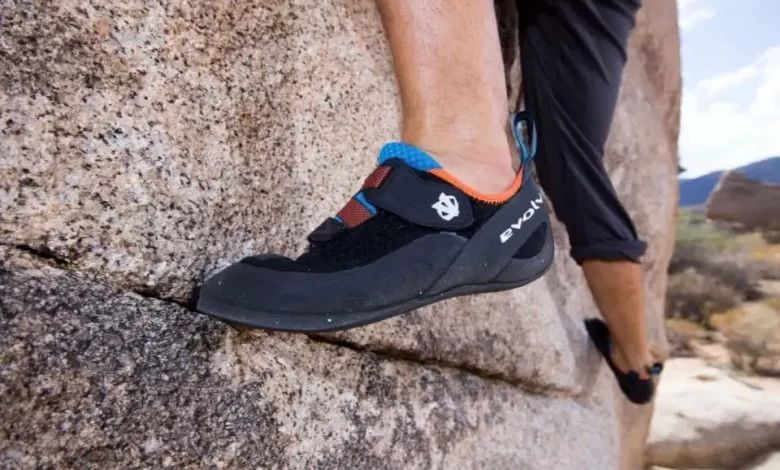
People who love adventure now have more options than ever when they want to choose shoes for rock climbing. So many different designs are there with innovation and technology for superb performance for indoor as well as outdoor climbing challenges. They are designed in a way to stick easily on plastic in the gym. There are also advanced versions that excel better on outdoor terrains. With a wide variety of climber’s shoes available at hand, it easy for you to pick one that fits your needs.
How to Choose the Best Intermediate Climbing Shoes for You
When it comes to rock climbing, how much discomfort a climber is willing to take in a shoe depends upon their expertise? This means that as you get experience and gain confidence in climbing, you would want to scarify comfort for better performance. When you start with the climbing sport, it is not advisable to buy an aggressive and tightly fitted pair of shoes for climbing. Once you gain experience and are ready to up your level, then you can get a technical shoe with a downturn and fitting.
Beginner pair are comfortable, but they cannot keep up with the crushing needed for the next level. You don’t want the beginner pair again.
But, you’re still not ready for advanced shoes that are too much for your comfort. You do want an upgrade to high performance while still having the versatile and comfortable feel for your feet.
We have just the right fit for you. Here are some of the best intermediate climbing shoes available to you. These perform well, are comfortable, and offer versatility for the intermediate climber.
You won’t have to break the bank to get there, and they’ll let you hook and edge while leveling up without the discomfort that comes with high-end performance shoes.
Here are our top picks for the best climbing shoes for the intermediate climber.
Best Intermediate Climbing Shoes Product Review
1. La Sportiva TarantuLace
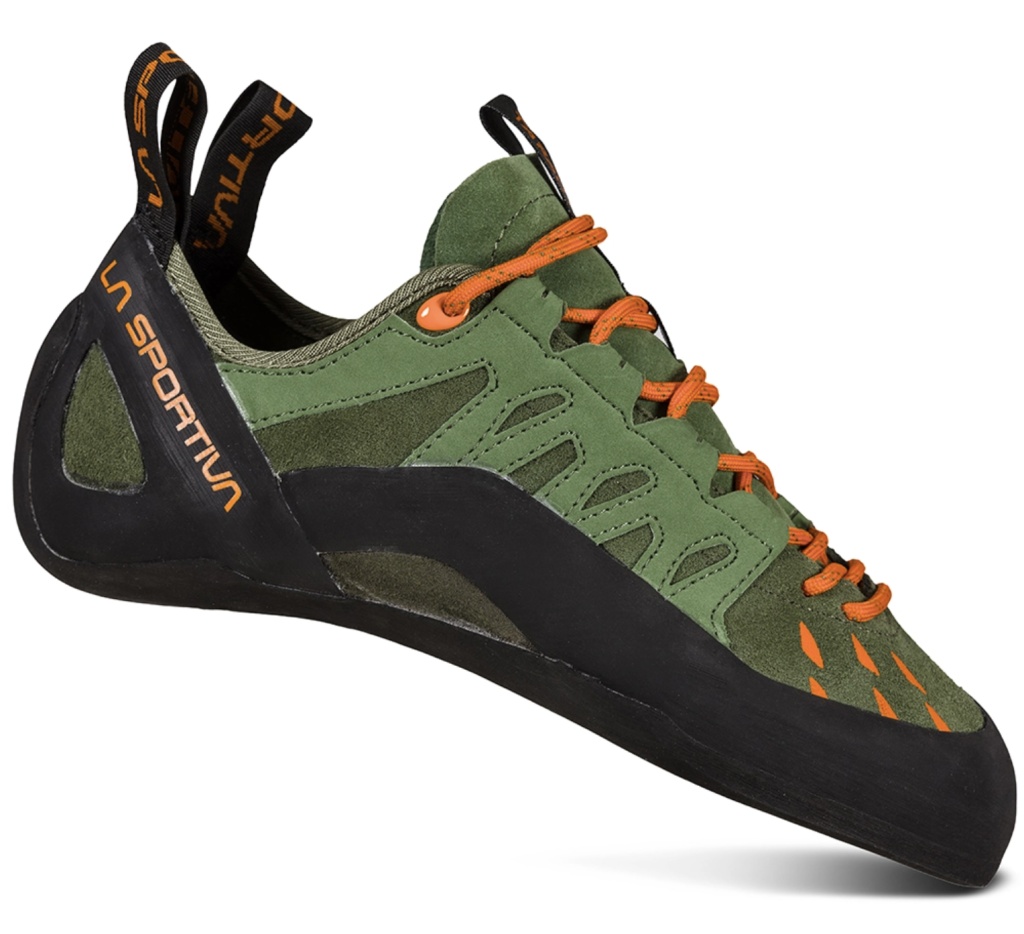
When you start out climbing and decide to get your shoes and ditch the gym rentals, the Tarantulace is a pair of fabulous shoes for climbing. You will get just the precision and grip you need, without crushing your toes. The Tarantulace are breathable and comfortable in the pocket too.
If you are a recreational climber or in the beginning phase of your climbing career, getting a premium performance shoe pair won’t be worth it. The La Sportiva Tarantulace costs less than half of high-end shoes for rock climbing. It has 5mm FriXion RS rubber sole fitted in, which is about 1 mm extra than the average pair of shoes. This means they are not only cost-effective, but they’re durable too.
You won’t get the edging performance or the precise fit of a high-end shoe. There are excellent choices for specialized climbing like a pocket or crack climbing. However, their performance is comparably impressive for their low price. Definitely one of the best intermediate climbing shoes.
Pros
- The flat midsole provides fantastic comfort.
- Its competitive price makes it affordable for the beginning climber.
- Tarantulace does not need break-in.
- Well balanced performance in many areas.
- Precision and grip to stick to gym plastics.
Cons
- Don’t perform well on steep terrains.
- The fit is imprecise.
2. Mad Rock Remora Climbing Shoe
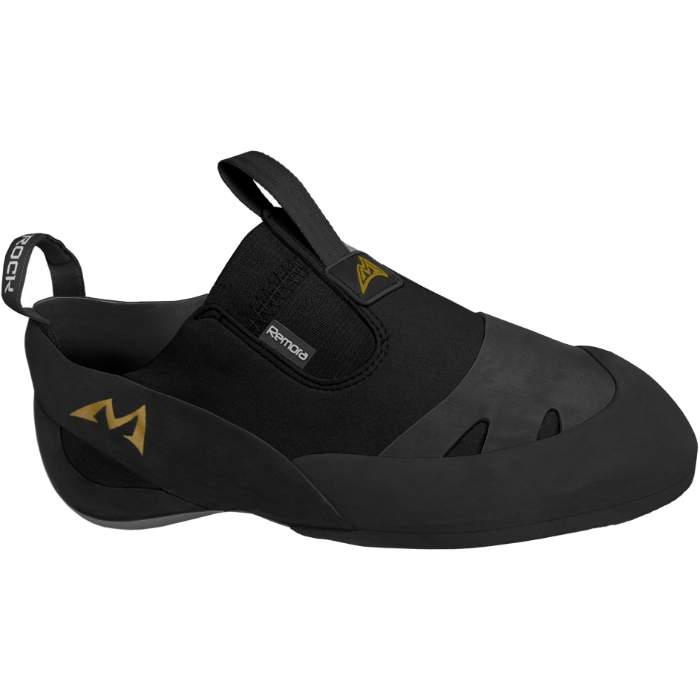
The Remora by Mad Rock is perfect for the climber transitioning from beginner to intermediate level. If you are someone who wants one pair that works for gym, sport routes and boulders alike, the Remora is that pair for you. It has a slight downturn and a moderate level of stiffness; this shoe is going to perform on steep terrains as well as vertical climbs.
The slip-on closure is easy to get in and out of. And thanks to the Synflex upper, there is not much stretch despite the slipper design. The Science Friction rubber wraps around the toes giving a snug feel, great to perform on vertical terrain.
The Remora might not be your best intermediate climbing shoes, but it is an affordable transition for the intermediate climber looking for something comfortable to wear all day long.
Pros
- It is a very affordable pair of shoes.
- Slipper makes it very easy to get in and out of.
- The rubber sole allows good crack climbing and toe hooking.
- It is an all-in-one shoe that works well both indoors and outdoors.
- The Remora is durable shoes for rock climbing.
Cons
- It might fit tight initially and will soften to conform to your feet later.
- This shoe has a full toe box that might cause some dead space.
3. Five Ten Men’s Leather Gambit VCS Rock Climbing Shoes
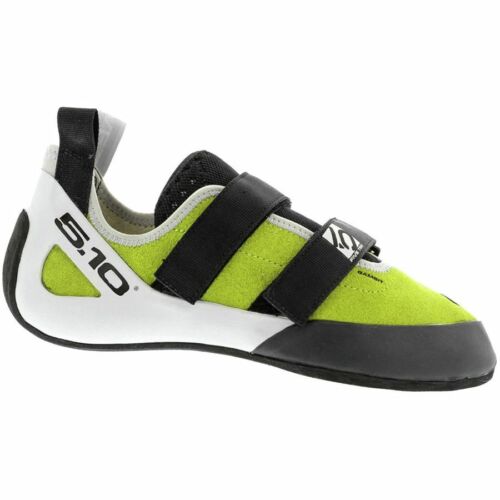
The Gambit VCS Rock by Five Ten is a comfortable semi-technical pair of shoes for the climbing gym, slab, trad, and long routes. This shoe is suitable for beginners as well as intermediate climbers. One of the useful features is gambit has a narrow fit. It offers excellent performance providing more support and less sensitivity. That is why middle and low-grade climbers are going to benefit from these the most. If you are set on going to long granite climb, this can be your perfect partner.
Pros
- These are a great blend of performance and comfort.
- These are very breathable.
- The rubber sole is an excellent mixture of stiffness, stickiness, and durability.
- The Ariaprene tongue keeps the sweat away.
- The Gambit is a durable pair of shoes for rock climbing.
Cons
- They aren’t as high for heel hooking.
- While they are comfortable to wear for long routes, they are not as aggressive as other intermediate level climbing shoes.
4. Black Diamond Momentum Lace Climbing Shoes
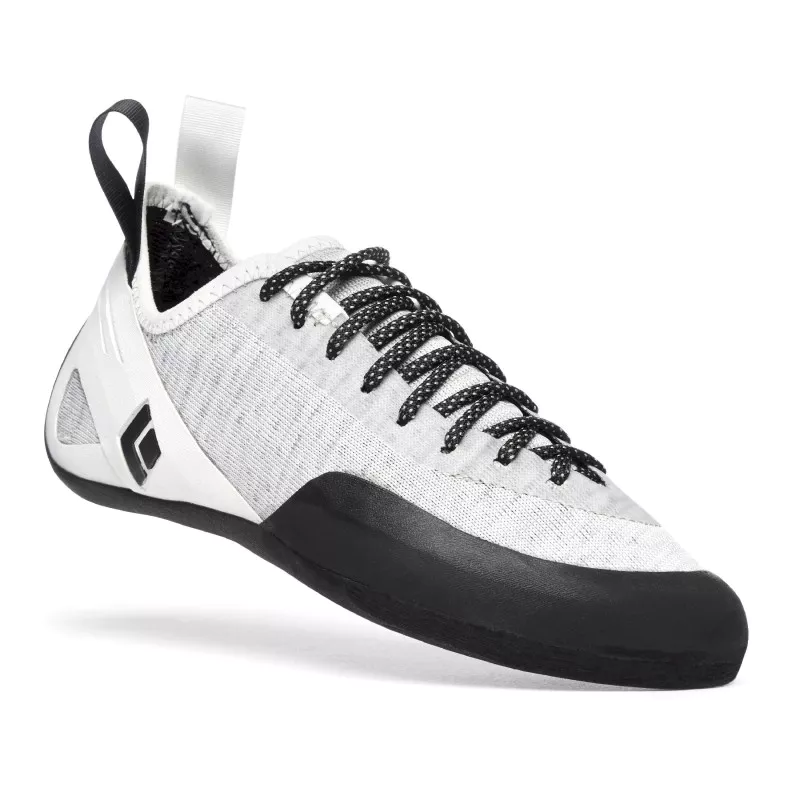
The Momentum has a unique Knit weave that makes it highly breathable and comfortable to use both indoors and outdoors. This exclusive Knit upper wicks away the moisture so your feet won’t ever get wet even on the days when you are sweating profusely.
It has a Velcro two-strap closure making it easy to wear and take off. The Momentum by Black Diamond offers limited performance but exceptional comfort. Its sole is made of 4.3mm neo-friction rubber that’s super thick and sticky enough to make sure you get ample support in your early climbing days. The knit upper is not very soft and won’t stretch too much. All in all, the BD Momentum are durable and comfortable shoes for climbing great for climbers with narrow feet.
Pros
- Their unique design and thick sole make them highly durable climber’s shoes.
- The Momentum is inexpensive.
- The unique Knit upper keeps the shoes very breathable.
- The flat shape allows comfort all day long.
- The Velcro closure makes getting in and out of the shoes very easy.
Cons
- These are not performance-oriented and not an excellent choice for edgers.
- With a narrow make and minimal stretch, they might get uncomfortable for people with wide feet.
5. Evolv Men’s Defy Climbing Shoes
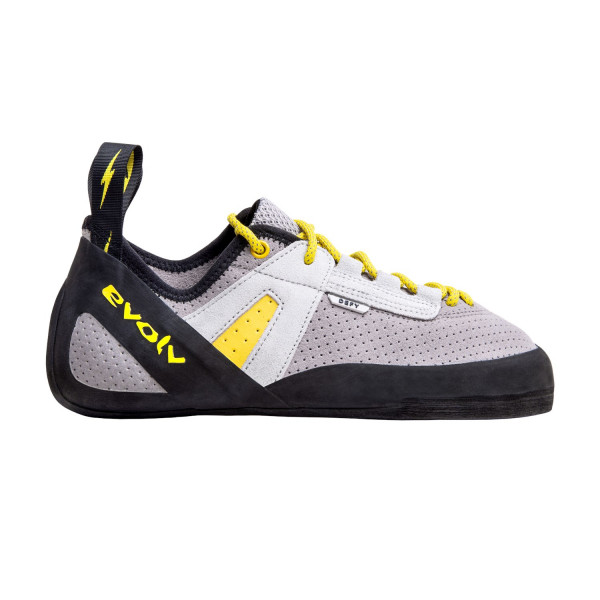
The Evolv Defy offers excellent value as intermediate shoes. They provide enough comfort to be worn old day and will help you do almost all the things decently except for extreme edging. It means they are great to use in the gym and participate in low-level climbing. Their upper is synthetic and non-stretchable. The Defy sport a flat profile, but they are very flexible and soft performing great on steep terrains as well. But this means you have to have healthy feet to perform well as these are not stiff or aggressively downturned.
Pros
- Their flat profile ensures comfort for all day.
- The Defy break in fast.
- The Velcro closure makes it easy to get in and out of these shoes.
- The Defy offers excellent value for money.
- It also provides excellent heel-hooking.
Cons
- The Defy has a loose fit.
- The Defy is not the best choice for extreme edging.
6. Scarpa Men’s Vapor V Climbing Shoe
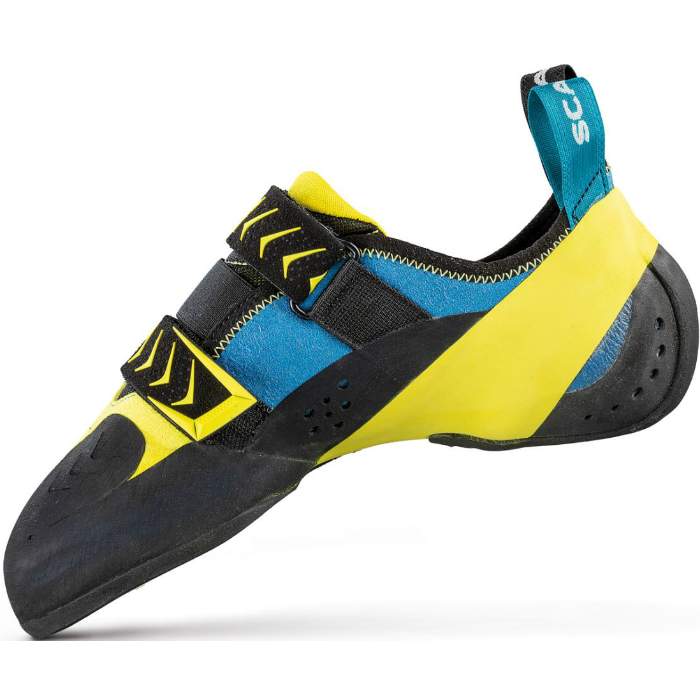
If you think you learn quickly and are serious about rock climbing, the Scarpa Vapor V might just be the choice for you. Being very versatile, it excels as a neutral shoe on steep technical terrain.
If you have more full feet, consider the Vapor V with a stretchable upper made of soft suede with a mesh-lined tongue. Vapor V is a great contender in the intermediate shoe category performing great with every climbing style. It is designed to edge well as well as provide support on overhung terrain. It a performance-oriented shoe and priced accordingly.
Pros
- The Scarpa Vapor V delivers excellent support in overhung terrain.
- It performs well in thin cracks.
- Great for climbers with more full feet.
- Supportive, outstanding performance in tiny crevices.
- The Velcro closure makes it easy to wear and easy to take off.
- The Vapor V is versatile and performance-oriented shoes for rock climbing.
Cons
- The Vapor V is performance-oriented means it isn’t as sensitive as the other softer options.
- Its buckles may cause pain in more extensive cracks.
Buyer’s Guide to Pick Best Intermediate Climbing Shoes
Choosing a Shape
Typically there are three types of shapes or downturn for climbers’ shoes.
- Neutral
- Moderate
- Aggressive
Neutral
These have a flat profile as well as ut provides comfort all day. Moreover, they are useful for trad climbing, multi-pitch climbing, smears, and cracks.
Moderate
With a slight downturn, moderate shoes strike a balance between performance and comfort. They are useful in vertical climbing and slightly steep rock.
Aggressive
Heavily downturned, these are ultimate performance shoes. They’ll work great on steep terrains and overhung rocks. These are the best shoes for bouldering.
Choosing a Closure System
Typically shoes have a slip-on system, laces or Velcro straps. Each one is discussed here with their pros and cons so you can choose which one suits you.
Slippers
Slippers are quickest to get on and off and work great at crack climbing. They are highly comfortable. They don’t provide as a Velcro closure would. It also doesn’t have as much heel hook prowess as its contenders. Because of slipping on and off, over and over, they tend to stretch a lot with time.
Laces
Laces give you the most precise fit. You can always loosen them up for comfort. Similarly, when you want, you can tighten them down for performance. Laces are great for trad, multi-pitch, and sports climbing. They are slow to take on and off.
Velcro
Velcro is easy and quick to tighten. It is more secure than the slippers but less secure than the laces. Velcro works great for indoor and sports climbing as well as bouldering.
The Rubber Sole
Usually, the rubber sole has a 3mm, 4mm, or 5 mm thickness.
3mm
At 3mm, the rubber is susceptible and soft. It will wear off quickly and will excel at smearing. The 3mm feels stickier.
It doesn’t edge very well.
4mm
This medium-soft rubber strikes the right balance between durability and sensitivity. It can edge well and smear well. But the 4mm is not supposed to excel in any category.
5mm
The 5mm rubber is both stiff and durable as well as excels at edging but lacks sensitivity. Might feel slick at times. This one doesn’t smear very well.
Upper Material
Usually, the upper material of shoes for rock climbing is made of lined or unlined leather or synthetic material.
Unlined Leather
Unlined leather has excellent breathability, which means the stink is minimal. It will stretch up to full size, so buy yours accordingly. As far as the fit is concerned, unlined leather will initially mold to your feet but tends to loosen up over time.
Lined Leather
The lined leather also has a significant amount of breathability, but it will have a fair amount of stink too. Because of the lining, its stretch will be about half a size or less than that. It decently molds to your feet but not as much as the unlined one.
Synthetics
Synthetics aren’t supposed to be breathable, and the stink after prolonged use can be similar to that of a beached whale (which means a lot). Synthetic material won’t stretch over time, so buy those which fit you the best. Synthetic provides minimal molding when it comes to the shoe fit.
Asymmetry
The symmetry of the shoes for climbing has to do with comfort and performance. The more asymmetrical the shoes are, the more the climber will get power in the big toe, for precision and better edging. Asymmetrical shoes tend to be uncomfortable.
When shoes have more symmetry, there’s less power in the big toe, which means less performance. These shoes tend to be comfortable.
Midsole Flexibility
How flexible or rigid is the midsole of your shoes for rock climbing depends on your level of experience in climbing. The more flexible midsole will mean high performance and more rigid midsole would mean more support and stability. So you pick according to your climbing needs.
Flexible (No Midsole)
These are ideal for technical climbing and bouldering. It excels at steep rock and smearing.
Medium (3/4 Midsole)
These are great for all-around performance. With medium flexibility, you get support for edging and latitude in technical climbing. These can very well turn out to be the best intermediate climbing shoes.
Rigid (Full Midsole)
These are ideal for sport, multi-pitch, and face climbs. The rigid midsole also excels at edging. There’s extra foot support to give you stability.
Signs of a Perfect Fit
- The heel has a snug fit.
- There isn’t any extra dead space.
- There are no pressure points.
- It fits the shape of your foot.
- Its width is adequate.
- The toes do not have to curl painfully.
Tips To Fit Your Shoes for Rock Climbing
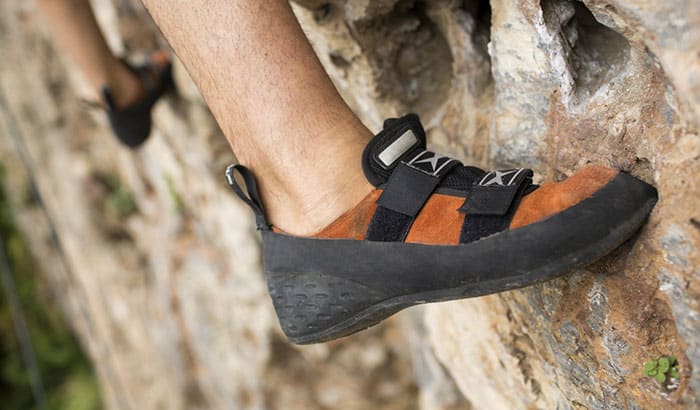
- Try to climb with the shoes on in the climbing gym or store where there’s climbing.
- Go for shoe fitting in the afternoon because feet swell up throughout the day.
- Leather shoes stretch over time, take this factor into account.
- Before starting your search for your shoes for climbing, know your specific needs.
- When fitting your shoes, don’t wear socks to get the best fit.
- If your feet are narrow and heels are small, try women’s versions as they have a lower volume.
Frequently Asked Questions
Q: Should my shoes for climbing hurt?
A: Climbers’ shoes serve as your foot’s extension that enables you to stick to and grip different kinds of footholds. While many shoes for rock climbing are uncomfortable, still remember that it does not mean you get a hurtful fit. Get a pair of shoes that fit your feet snug while letting you feel the dimples and nubbins on the rock. In case your shoes are super tight so much so that you are unable to focus on your climbing, you should rethink your fit and see if you have your correct size or not.
Q: I am new at climbing. Shall I get aggressive shoes for rock climbing?
A: Being a beginner, you should go for comfort first and performance later. This way, you can focus on learning how to climb without the stress of uncomfortable shoes. Plus, beginner rock climbing shoes are often inexpensive than performance.
Climbing shoes that have a flat profile give the utmost comfort, whereas the ones with a downturned profile provide superb performance. Some people prefer to begin climbing with performance-oriented shoes. And that’s alright as long as they can endure the discomfort that comes with an aggressive pair of shoes.
Q: Which closure system is best for the best climbing shoes?
A: This depends upon what you prefer. Like we discussed, mainly three types of closures are there in the shoes for climbing – lace-up, slip-on, and Velcro. Lace-up offers a versatile fit where you can tighten or loosen up according to your choice. Slip-on usually serve the purpose of training as they lack adjustability, and they stretch off with time. Velcro provides a secure adjusted fit with its hook-n-loop make.
Q: What would be the perfect size for my best climbing shoes?
A: If you have decided on a specific model or brand to buy, look up its reviews online. Check out the brand’s website and see their size chart and recommendations for sizing. Some manufactures advise getting a half or a full size down your regular shoe size. Keep that information in mind when you are trying a pair on at a local store. Plus, it is advisable to shop late in the afternoon hours and know the return policy of the store before buying.
Q: Can I get the best beginner climbing shoes at a low price?
A: There are the best climbing shoes that are inexpensive. Beginners’ shoes for climbing are exceptionally cheap. With a little research on the internet, you can find your pair of best beginner climbing shoes at a meager price. They are usually in a neutral profile and cost less than a hundred dollars.
Q: What will be the best climbing shoes for me?
A: Only you can answer this question for yourself. There might be a pair of shoes that all your friends wear, it may still not be working for you. Your best climbing shoes depend on your level of pain tolerance, the kind of climber that you are, and your desired style of shoes.
Q: My shoe sole is wearing off, do I get a new sole or new shoes?
A: At times, you develop a secure attachment to your existing pair of shoes and don’t want to part ways with them. In such a situation, just get a new sole. Keep your shoe condition in check after each use so you’d know when it’s time to get a new sole or a new pair of shoes.
Q: How to get rid of the stink of the shoes?
A: If your shoes aren’t breathable, they might stink after use. You can prevent the smell by letting the shoes dry after every use. After a climb, hang the shoes with all the closures opened. Don’t keep them in a bag. Wash the shoes using a mild soap and a soft brush. Air dry them after the wash.
Wrap Up
If you’ve read this guide till here, you are now familiar with all the kinds of shoes for rock climbing that may come your way, and you can distinctly tell them apart with their features. If you are a leveling up your climbing game, our selection of the best intermediate climbing shoes, definitely have something for you.
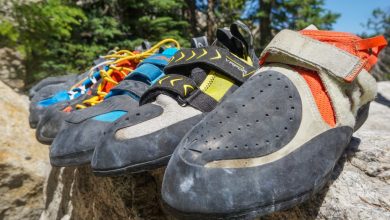
One Comment